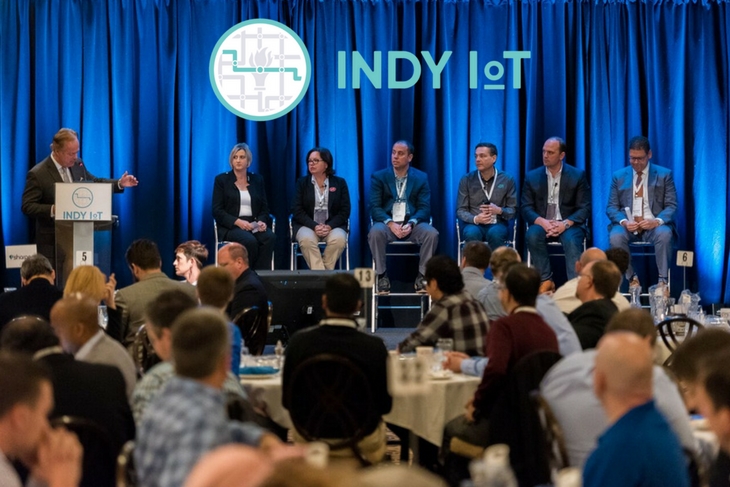‘The New Crossroads of IoT’ – where Indiana’s backbone meets the Internet of Things
Every conference I’ve attended lately kicks off with thought-provoking ideas or questions that frame the day’s presentations. At IndyIoT on Wednesday, Oct. 25, that meant hearing ClearObject CEO John McDonald list three opinions that really stuck with me:
- In five to seven years, we’ll have cars that drive us.
- IoT of tomorrow asks why things aren’t connected, not why they are.
- Everyday devices are getting smart. The iPhone has 12 sensors – our body has five.
The difference between this conference and those I normally attend is that at IndyIoT, we’re not just talking about the future. We’re participating in it.
The third annual IndyIoT event (and inaugural 2017 Mira Awards People’s Choice Winner for Best Tech Event) convened to demonstrate “the new crossroads of IoT,” where the backbone of Indiana’s 200-year-old economy — manufacturing, agriculture, and transportation — meets the Internet of Things (IoT).
Why should Indiana care about this? According to Fishers Mayor Scott Fadness, “there are 70,000 less people working in manufacturing today than 10 years ago. We need to pivot our economy to where Hoosiers will find work.” As much as the event focuses on new technologies, there’s an underlying workforce theme present in the keynote and individual sessions. How will Hoosiers prepare for these jobs of the future? “It’s not just about growing the tech sector,” said Fadness, “but what environments do we create and how do we connect today’s economy to the past?”

“We’re building a new vocabulary. [In Indiana], ‘tech’ used to mean email marketing, ExactTarget, and Salesforce. Now, it’s that and big data, analytics, and IoT,” Fadness elaborated.
This bridge between Indiana’s leading industries and the jobs of tomorrow were seen in presentations from The Clarke Solutions, Rolls-Royce, Lely, and the State of Indiana.
In just 40 short minutes, IndyIoT attendees were captivated by discussions of the fourth industrial revolution, robotic dairy farming, and unmanned ships and planes that are being developed and tested today.
John Duffin, president of The Clarke Solutions, started his presentation by noting the candy positioned at each attendee’s seat. “Some of you might have just wrappers instead of candy,” he said, creating a scenario to launch into his presentation about predictive analysis. “The IoT value chain creates actionable intelligence, notifying the right people in real time to improve efficiency,” ultimately meaning those of us who got empty candy wrappers could have had a better, melt-in-your-mouth outcome. “We’re moving from quality control to quality assurance, preventing errors before they occur.” The Clarke Solutions provides measurable results for well-known life-sciences, food and beverage, and consumer-manufacturing Fortune 500 firms.
Tiffany White, Chief Project Engineer at Rolls-Royce, convinced the audience that the 106-year-old company she works for is a “digital innovator.” Rolls-Royce is using turbomachinery and IoT to give planes the ability to autonomously take off and land at prepared and unprepared landing zones, with unmanned operations flying at above 60,000 feet and for 32+ hours per mission. Earlier this year, Rolls-Royce was the first to demonstrate an autonomous ship, which they are experimenting with in Finland. Soon, the ship will be able to autonomously dock itself and self-diagnose its operations. “With IoT, we can have an integrated supply chain,” said Tiffany.
Venessa Knoblock, Regional Sales Specialist at Lely, enlightened attendees on the digital transformation of farming and agriculture, and that “it’s more than cows, sows and plows. Surprisingly, there’s a lot of data in manure.” Venessa played a video highlighting how Lely, a provider of robotics for dairy farming, is creating sustainability for both the environment and the economy. “Indiana will boast being the largest robotic dairy farming in the world,” she said, to which I visualized the blue jackets of the FFA youth as they walk around downtown Indianapolis for their national convention, and how they really are working in the jobs of the future.
“Sharpen is proud to be a part of an event that brings officials and business leaders statewide together to acknowledge the importance of IoT in maintaining Indiana’s position as a trailblazer in the new economy,” said Cameron Weeks, CEO of Sharpen. “From agriculture to manufacturing, transportation and logistics, Indiana’s biggest industries are quickly recognizing the power and economic impact of IoT on our jobs and lives.
“As a leader in IoT in Indiana and across the U.S., Sharpen remains committed to helping companies embrace this new level of connection by helping them leverage IoT to deliver proactive customer service through new initiatives such as our latest platform solution,” weeks said. “We will continue to work alongside leading Hoosier companies in the IoT field and help others learn how to transform their own organizations with new IoT initiatives that will alter the landscape of our daily lives.”
IndyIoT did a fabulous job of bringing together the conversation about yesterday’s economy, today’s workforce, and tomorrow’s innovation. This “new crossroads of IoT” dialog will continue through a podcast partnership with Inside INdiana Business called The New Crossroads. Find the first episode here and visit the IndyIoT event website to stay in touch about 2018’s event.



